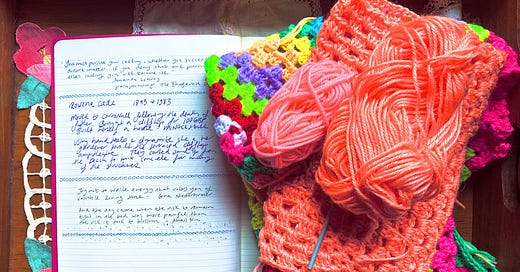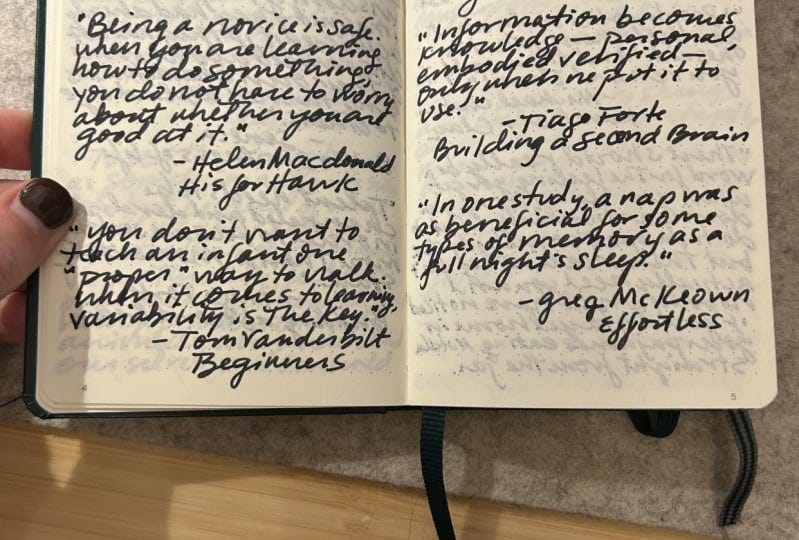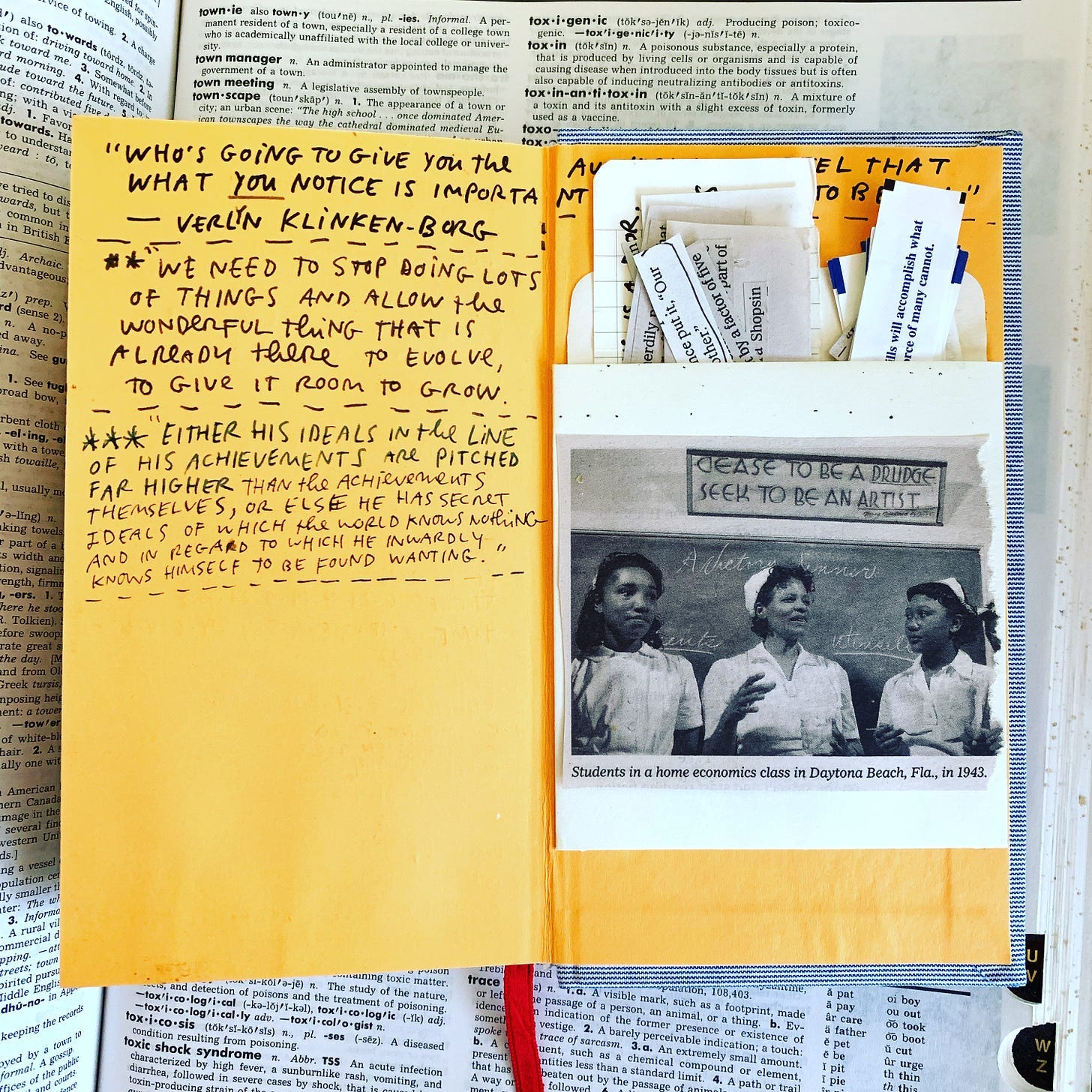Let's all Commonplace?
Commonplacing crafts a lens to peer at life through, steers us on and makes us memorable.
Hello Wallflowers and friends,
Look. Probably you are much cleverer than I am. It’s likely you’ve known all about Commonplace Books for ages. I only found out about them last year and I was immediately hooked on the idea of creating a curious sort of knowledge archive of things that piqued my interest and warranted documenting. If you’re new to the idea (like I was) and are trying to picture a Commonplace Book’s contents, think handwritten journal, but (generally) with less of a ‘dear diary’ vibe and more of a scrapbook of factual interestingness that warrants memorialising.
The contents of a Commonplace Book are generally handwritten and might include quotes, ideas, reading notes, recipes, lyrics, interesting facts, snippets from a fortune cookie, poems, photographs, domestic notes, sketches, collected ephemera, dreams, lists and … sky’s the limit, dear reader. The rules are there are no real rules. It’s all about what catches your eye, hooks your brain and deserves documenting.
An oldie but a goodie
Originating waayyyy back in Ancient Greek times (hey, Aristotle) as a knowledge-gathering practice, Commonplace Books have endured through the Renaissance, through the Enlightenment, on and on, and into this century with a whole bunch of people still commonplacing their favourite notable things. (Just search for “Commonplace Book” on YouTube or Medium to be inundated with contemporary inspiration.)
Above: Caroline Donahue’s Commonplace Book via
Scholar Susan M. Stabile likens the Commonplace Book to a kind of textual curiosity cabinet or Wunderkammer which is a pretty apt description. Susan has authored a brilliant book called Memory’s Daughters: The Material Culture of Remembrance in 18th Century America in which she discusses the popularity of commonplace books during that era. She says that collecting small, memorable, and useful ideas was considered a key aspect of refined education and polite learning.
Home and hearth
I think the 18th century-onwards commonplacing practice is also staking a claim for the legitimacy and memorialising of ideas that might be close to home or domestic (where ‘the domestic’ is often dismissed as 'women’s work’ or unimportant or just small and boring.)
“As compilers and authors [18th century American women] established a … domestic form of publication,” which were kept by women and passed on to their daughters or other family members. “The diary and the commonplace book, as collections of past reading, became collections for future browsing,” Susan writes.
In this way, Commonplace Books become a valuable record of lives once lived, capturing the zeitgeist of the day from those who lived it, domestic or otherwise.
Any thought might do
Mrs Jameson’s Commonplace Book of Thoughts, Memories and Fancies, published in 1855 and available to view online, includes thoughts on theology, ethics, character, literature and art, for instance.
“For many years I have been accustomed to make a memorandum of any thought which might come across me,” she explains in the introduction to her 150-odd-page work which contains various still-relevant ideas (and thoughts) interspersed with pretty illustrations.
Above: Extract from 1855’s Mrs Jameson’s Commonplace Book of Thoughts, Memories and Fancies. It reads: “While we were discussing Balzac’s celebrity as a romance writer, she (O.G.) said, with a shudder: “His laurels are steeped in the tears of women, – every truth he tell has been wrung in the tortures of some women’s heart.”
Your city’s online library archive will likely have access to a whole bunch of online papers around this commonplacing practice. For example near me The State Library of Victoria is free to join and you can view lots of commonplace book spreads from the comfort of your home via their ‘search’ option. If you can access a university library, even better!
Above: 18th century sea captain’s Commonplace Book via
Baffled delight
Commonplace Books are a pick and mix of collected curiosities and making sense of them can often be a sort of rollercoaster ride, perhaps best understood by the ‘commonplacer’ themself. As scholar Adam Smythe notes:
“The experience of reading manuscript commonplace books is often an experience of baffled delight – delight at pages so crammed with text that annotations spill over to the binding and covers; at devotional aphorisms jostling with bawdy epigrams and recipes (‘Unto the lorde haue I lyfte up my soule’; ‘to preserve plumes or Damsins’); at scraps of printed pages glued into the manuscript; at prose merging with verse merging with financial accounts merging with illustrations; at blank pages, and gaps …” (via)
Above: Austen Kleon’s Commonplace Book via
Chosen commonplaced ‘texts’ – be they proverbs or poems or riddles or photographs or other –are not a hard and fast rule for approaching life, but more a way of cultivating knowledge, understanding ourselves and the things that interest us most. A kind of lens from which to peer at life through and steer on.
Bascially, the Commonplace Book is something we likely all need in our lives. If only we could tear ourselves away from our screens long enough to update them? Perhaps the new surge in popularity of ‘junk journalling’ is a hybrid response to this dilemma?
Thanks for reading, Wallflowers!
Pip x
Below: Martina Calvi’s junk journal via
Further reading:
Archer and Olive. (2015). Archer and Olive. Archer and Olive. https://www.archerandolive.com/en-au/blogs/news/what-is-a-commonplace-book-and-how-to-start-one
Granger, R. (2024). How (& why) to start a Commonplace Book. YouTube.
Kleon, A. (2023, February 28). Inside my commonplace diary. Substack.com; Austin Kleon. https://austinkleon.substack.com/p/inside-my-commonplace-diary
Smythe, A. (2010). Commonplace Book Culture: A List of Sixteen Traits. In A. Lawrence-Mathers & P. Hardman (Eds.), The Domestication of Print Culture (p. pp. 90 - 110). Boydell & Brewer.
Stabile, S. (2009). Female Curiosities: The Transatlantic Female. In C. E. Kelly & H. Brayman Hackel (Eds.), Reading Women : Literacy, Authorship, and Culture in the Atlantic World (pp. 217–243). University Of Pennsylvania Press.
Stabile, S. (2018). Memory’s Daughters : The Material Culture of Remembrance in Eighteenth-Century America. Cornell University Press.
Weishar, L. (2021, February 17). The Joys of Keeping a Commonplace Book. Verily. https://verilymag.com/2021/02/keeping-a-commonplace-how-to-bullet-journal-hobby










I think I might already do this but in a scattered way. I copy down poems I like in a particular notebook, I’ll screenshot words and artwork on my ipad that resonate with me and keep special tickets or little cards that people send me etc. Even postcards that come with my bulb orders! I don’t know why but it has never occurred to me to keep it in all one place 🤔.
Love this first post Pip. I’ll be subscribing!
I am hoping that 2025 is the year I will journal more frequently. Last year I tried having different notebooks for different things but not everything is in the same book. I don't know if that is very commonplace-y but maybe it is?
I am so happy you are here, I couldn't sign myself up fast enough!